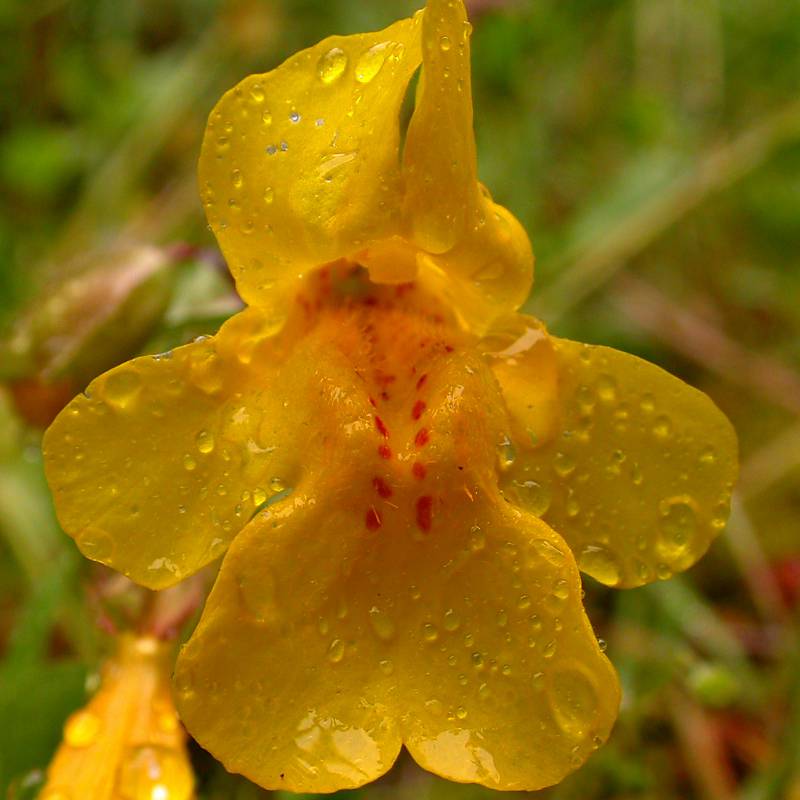Erythranthe microphylla
Erythranthe arvensis
small-leaved monkey-flower
field monkey-flower
Leaves basal and cauline, basal leaves occasionally deciduous by flowering;
petioles 3-5 mm from base to mid-stem, becoming sessile and nearly clasping to perfoliate distally;
blade commonly somewhat purple, narrowly ovate to ovate to elliptic to nearly orbicular, 10-35 mm long and 3-25 mm broad, palmate venation with 3-5 veins, base rounded to wedge or nearly heart-shaped, margins more or less crenate or nearly serrate with 5-10 teeth per side, basal and lower cauline leaves irregularly incised near base becoming nearly lyrate;
apex acute to obtuse-rounded, surfaces glabrous or with sparse to moderate coverage of small rigid hairs, eglandular.
Leaves basal and cauline, or basal leaves may not persist, mid-stem or higher leaves often largest and becoming smaller distally; petiolate, petioles 3-20, distally sessile;
blade ovate to orbicular to oblong, middle and distal cauline leaves may be orbicular to nearly reniform, generally 10-35 mm long and 6 to 26 broad, 3-5 palmately-arranged veins, earlobe-like appendages near base, base rounded to truncate to slightly cordate, margins distinctly toothed to nearly entire, larger plants show lower leaves lacerate lobed to pinnatifid margin bases, apex rounded, surfaces glabrous except bracts densely villous beneath and occasionally above, long eglandular hairs flattened and sometimes transparent.
Axillary flowers 1-8, emerging from nodes towards ends of stems; fruiting pedicels 8-30 mm, hairy-glandular as stems;
calyx nodding at 30-90 degrees, occasionally somewhat reddish or red-dotted, ovoid-campanulate to widely cylindric-campanulate, inflated, compressed across sagittal plane, usually 9-16 mm, hirtellous or glabrous, throat closing weakly or strongly;
corollas yellow to dark yellow to orangish yellow, typically with red spots, lower limb occasionally with large red splotch, symmetric bilaterally, bilabiate;
tube-throat widely funnel-shaped, 8-16 mm, protruding 2-6 mm beyond calyx margin;
limb expanded 8-25 mm, palate villous;
styles slightly hirtellous;
anthers not protruding, glabrous.
Axillary flowers generally 3-8, emerging from distal-most nodes; fruiting pedicels eglandular and smooth, longer than subtending leaves, typically 5-40 mm;
calyx sometimes with red dots, ovate to campanulate, inflated, compressed along sagittal plane, 9-14 mm, slightly hirtellous, throat sometimes closed or open, lobes curving upward weakly, top lobe not significantly longer than lower lobe, not distinctly curved;
corollas yellow, commonly with red spots, weak bilateral symmetry or near radial symmetry, slightly bilabiate or almost regular;
tube-throat cylindric to funnel-shaped, 8-12 mm, protruding 1-2 mm past calyx margin;
limb expanded 5-10 mm;
styles glabrous;
anthers not protruding, glabrous.
Capsules 6-9 mm, included.
Capsules 6-7 mm, included, stalked.
Erythranthe microphylla
Erythranthe arvensis
- Local floras:
BC,
CA,
OR,
WA
- Local Web sites:
CalFlora,
CalPhotos,
Flora NW,
PNW Herbaria
WildflowerSearch
iNaturalist (observations)
- LBJ Wildflower Center
- SEINet
- Plants of the World Online
- Encyclopedia of Life
- Wikipedia
- Google Image Search
- Local floras:
BC,
CA,
OR,
WA
- Local Web sites:
CalFlora,
CalPhotos,
Flora NW,
PNW Herbaria
WildflowerSearch
iNaturalist (observations)
- LBJ Wildflower Center
- SEINet
- Plants of the World Online
- Encyclopedia of Life
- Wikipedia
- Google Image Search



